| Specifications Usage Tips | | Product Summary |
|---|
The Salli Twin is the model which introduced Salli's patented split saddle seat design. This seat is designed to correctly position the user in such a way that their back is moved into an optimum upright posture. Weight is transferred onto the sitting bones and off of soft tissue, reducing uncomfortable pressure points. The elevated seating position of the Salli Saddle naturally tilts the pelvis forward, moving the back into a corrected upright posture.
The Salli Twin's design encourages an upright stance and open core which facilitates upper-body movement and can provide many of the benefits currently being attributed to Standing Workstations without the necessity of being on one's feet throughout the day.
For cost-conscious users a more economical version of the Twin is now available. The Chin differs from the Twin only in that it has a lighter seat frame, standard (as compared to premium) components, a more limited warranty and fewer accessory and color options.
Note: If the split saddle concept appeals but you are looking for a more active sitting experience the Salli Sway, Swing and SwingFit models may be of interest as each of these offer an 'active' tilt and free-moving seat design.
Height adjustment of the gas spring lift is accomplished through a standard hand-controlled height adjustment lever. Available lift sizes and the corresponding heights they accommodate are as follows: Short (4'0" to 5'2"), Mid (5'1" to 6'1") and Tall (5'8" to 6'5"). The 5-point star base and lift are in an attractive chrome finish.The Salli Twin is only available by Special Order and can be purchased upholstered in either genuine leather or polyurethane faux leather, each available in a range of colours. | | Ergonomic Benefits |
|---|
Freedom of Movement The design of the Salli Saddle Seats encourages the entire upper body to move more freely than a traditional chair. In the absence of side or back constraints users are able to freely lean, stretch, and arch as they wish. This freedom translates into improved back mobility as it remains in constant flex. The upward stance of this style of seat also increases alertness as the entire body becomes involved in the sitting experience.
Split Saddle Design The Salli Twin features Salli`s patented Split-seat saddle design. The centre groove (split) of the seat reduces the pressure on soft tissue and suspends the tailbone, relieving direct pressure on the spine. The split design also enables air movement that promotes cooling of the pelvic region, increasing comfort and providing health benefits for both men and women.
Correct Spinal Alignment (Improved Posture) All Salli Saddle Seats are designed to restore the correct alignment of the spine . This is accomplished when the user's pelvis is tipped forward due to the 45° downward angle of the thighs. The forward tilt of the pelvis restores the natural "S-Curve" of the spine, positioning it where it can best provide the support necessary for the torso, neck and head. Traditional chair seats actually force the lumbar portion of the spine outward (creating a 'C-Curve'), exerting unnatural and unsupported stress on the soft tissue muscles and ligaments of the lower back. The improved alignment of the spine which the Salli Saddle Seats promote alleviates or removes that stress, reducing fatigue by enabling those tissues to relax and rest. The Tilting Twin offers an users the opportunity to enhance the forward tilt of the pelvis to a greater degree than that basic Salli Saddle Seats.
Ability to Deviate from Upright Position Securely For users such as Dentists or Chiropractors the Salli Saddle Seats can provide a significant posture improvement over other types of seating. This is due to the anatomical position yielded by a correctly positioned saddle seat, angling the thigh downwards rather than directly in front of the user (i.e. 90°). The enables the practitioner to move significantly closer to the patient, hovering over them while maintaining a stable seating posture. This ability to 'move in' enables them to maintain a more upright posture which in turn reduces the strain on the lower back - an issue which is common in both of these groups or anyone else who performs repetitive forward or side-reaching tasks. It also enables them to exert greater force when necessary while at the same time reducing the effort required. The closer positioning also provides users with a greater degree of hand and finger contro
Reduced Potential for Lower Back Pain By positioning the spine in its naturally strongest and correctly aligned position the continuous tension and stress which traditional chairs place on the lumbar portion of the spine is relieved. Much back pain is a response generated by the soft tissues (muscles, ligaments, etc) to notify us that overuse, overstressing, or damage has been done to these tissues. This is a natural response by the body in an effort to advise us that something needs to be addressed. Ligaments and muscles are not designed to be held in constant tension. Over time ligaments lose their resiliency and are unable to return to their natural length (much like a rubber band will lose its original proportions once it is repeatedly stretched or held in an extended position). This will result in a greater stress on the muscles which are now required to exert extra continuous effort in order to aid the ligaments in providing the necessary support. Associated with this extra stress, muscles will often respond with cramping and spasms, usually accompanied by pain.
Reduced "Overreach" A complaint commonly associated with traditional seating is that it is difficult to reach items positioned to the sides or front. Doing so requires a significant rotation forward or outward from the shoulder, often combined with a forward bend from the waist. This can be a cause for concern for two reasons. First, the extreme reaching of the arms and the high degree of rotation necessary to accomplish this can lead to the development of shoulder-related issues. Usually this is addressed by trying to adapt the work area to the user by bringing frequently used items and equipment closer. However, there is always a limitation to the comfort zone of the user so this is usually only partially effective as a solution. The second area of concern related to the overreach is that when items are out of reach users will attempt to extend the limited range of their arms by 'bending' or 'stretching' forward from the waist. This exerts unnatural and unnecessary stress on the lower back, increasing the potential for development of lower back pain. A Salli Saddle seat addresses both of these concerns by providing a significantly increased reaching zone. The forward tilt of the pelvis immediately provides several inches of additional forward reach that cannot be available when seated in a traditional chair as the upper body is brought into closer proximity to the work space. In combination with this is the fact that a saddle seat position permits the entire torso to accomplish the reach, rather than relying on a single joint such as the shoulder. By spreading the reaching movement throughout the upper body not only are users able to reduce the angle of the shoulder rotation but also the potential for stress on the lower back. The result of this is that the reach of an average user can easily and comfortably be extended 12" - 18" beyond what they could normally reach from a traditional chair.
Achieve Sit/Stand Benefits WITHOUT Standing The upright posture which the Salli Twin offers can help the user realize many of the benefits attributed to an active standing posture without some of the accompanying concerns. Posture is improved, blood flow is increased due to the greater degree of movement offered, and improved overall abdominal activity due to the open and upright stance ensures improved bloodflow and increased metabolism. This automatically results in a greater degree of alertness and the ability to better focus on the tasks at hand.
Avoids the Risk Factors of Standing When Working Standing to work is rapidly gaining in popularity due to solid scientific evidence that extended sitting in the traditional office environment greatly increases numerous health risks. Current media coverage which is to a great extent fueling this movement has almost solely focused on the "benefits" of standing to work, ignoring the equally compelling evidence that extended standing can also be extremely detrimental to one's overall health. Studies have shown that extended standing can result in blood pooling in the lower legs due to the static state of the leg muscles, resulting in edema (swelling of the feet and lower legs) and a corresponding increase in varicose vein problems. This also increases the load on the circulatory system which has to push this pooled blood back out of the legs. There is good evidence that this can exacerbate existing or possibly lead to heart and circulatory problems. Many people who stand extensively, especially on hard floors (concrete, ceramic tile, etc), develop heel problems that can manifest as bone spurs or plantar fasciitis. Standing is also more tiring, something which is has been well-known in industry for many years. While standing does burn more calories it is also rated to consume 20% more energy than sitting which can result in fatigue. Industry has addressed this by providing anti-fatigue mats, anti-fatigue footwear, and chairs to sit on during rest breaks - each of which is aimed to reduce the tiring effects of standing. Salli Saddle Seats enable users to maintain the upright posture which is most beneficial to their health while at the same time reducing their exposure to the risk factors described above. Since the Saddle Seat carries the majority of the weight load the leg muscles are no longer required to remain in 'tension' mode in order to support the user. Instead, these muscles are now free to relax and flex as needed to move the chair around the work area. This movement activates the 'pumping action' that aids in moving blood from the lower legs. By transferring the majority of the weight to the Saddle Seat, the feet are also permitted to rest, reducing the ongoing strain that occurs with extended static standing.
IMPORTANT NOTE Working in a Salli Saddle Seat will generally require some modifications to the workstation. Since it elevates the torso of the user there will be a requirement to ensure that keyboard, mouse and monitor are all able to be brought into an appropriate height position in order to maintain a neutral posture for the hands, arms, and neck. For shorter users this might be able to be accomplished by elevating the desk using specialized lifters such as Raise-Its which can safely raise a desk by up to 3". Standard keyboard arms and trays may also provide enough elevation or may be utilized in combination with a product like the Raise-Its. The monitor mount may have enough range to elevate the screen to the desired greater height or a few simple monitor risers in combination with it's integral movement may provide the necessary elevation. For more complex scenarios such as taller users it may be necessary to provide an elevating workstation that can be raised enough to bring these devices into the correct alignment. The advantage that a Saddle Seat offers over a Sit/Stand workstation is that the user is still in a seated position and the monitor and keyboard do not need to shift throughout the day as the range of motion and viewing angles do not change. However, for a Sit/Stand Workstation to be properly equipped it will need to accommodate the changes which occur when the user switches from Sitting to Standing. These include small but significant changes in the hand/arm positions and more significant changes in the viewing angle required for the monitor. This may often require a monitor arm with a fairly wide range of elevation adjustment, adding additional cost to the adaptation.
| | Features |
|---|
- Adjustable Height Options: Four different lift heights are available - enabling the Salli Tilting Twin to meet the seating heights of users ranging from 4' to 6'5" or over.
- Short fits 4'0" to 5'2" (Seat height 18.5" -23")
- Mid fits 5'1" to 6'1" (Seat height 22.5"-30")
- Tall fits 5'8" and over (Seat height 25"-35")
- Quality Upholst: Available upholstery options are:
- Black Genuine Leather
- Other Colours of Leather and Naugasoft Surgical Vinyl are available by Special Order
>
Easy Rolling: Five 65mm casters (for hard floors) on the polished aluminum base enable users to use their feet in a push/pull motion to roll around a work area with minimal effort.Weight Rating: The Salli Twin is designed to safely support users up to 264 lbs (120kg). The Salli Strong is recommended for those exceeding this rating.Quality Upholstery: Available upholstery options are:Black Genuine Leather Other Colours of Leather and Naugasoft Surgical Vinyl are available by Special Order > | | Images and Multimedia |
|---|
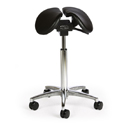
Salli Twin
| 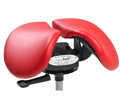
Salli Split Saddle Closeup
| 
Salli Twin Spec Image
| 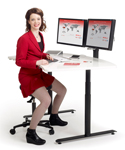
Salli Saddle Seat in Use
| 
Salli Saddle Seat in Use - 2
| 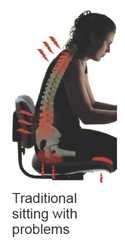
Traditional Seats Damage Posture
| 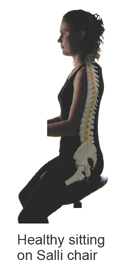
Salli Seat Improve Posture
|
| | Models |
|---|
| For related products, visit our online product listing. | | Model # | Description | TD Synnex SKU |
|---|
| SS-TW | Salli Twin Chair, fixed width divided seat, medium pneumatic chrome lift, polished aluminum base, soft 65 mm casters, accommodates users up to 264 lbs (120 kg) | |
| | Accessories |
|---|
| Model # | Description |
|---|
| 43565H | Salli Hard Standard Caster Accessory, 65 mm, for soft floors or wall-to-wall thick carpets (Note: Price is for 1 unit, order 5 if you want a complete set for a Salli Chair). | | 440 | Salli Hard Caster Glide Accessory, converts Salli chair for stationary use, permits chair to glide when not loaded (Note: Price is for 1 unit, order 5 if you want a complete set for a Salli Chair). |
|
|